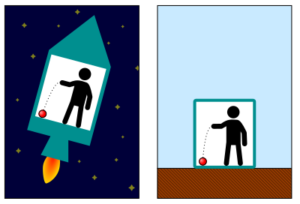Table of Contents
Dimensions Of Acceleration Due To Gravity: Acceleration due to gravity is indeed the acceleration gained by an object as a result of the gravitational force. The SI unit for it is ms². This really has both a magnitude and a direction. So that, it is a vector quantity.
The symbol g is used to portray gravity’s acceleration. It has a standard value of 9.8 ms2 on the earth’s surface at sea level. The formula for its computation is based on Newton’s Second Law of Motion and Newton’s Law of Universal Gravitation.
The acceleration due to gravity has been calculated using Newton’s Second Law of Motion and Newton’s Law of Universal Gravitation. Those same two laws result in the most practical form of the acceleration due to the gravity formula: g = G*M/R2, where g is the acceleration due to gravity, G is said to be the universal gravitational constant, M is mass, and R is distance.

Formula of Acceleration due to Gravity
f = mg signifies the gravitational force acting on a body.
For which f denotes the force acting on the body, g denotes the acceleration due to gravity, and m denotes the body’s mass.
f = GmM/(r+h)2 would be the universal law of gravitation.
Here,
- f = force between two bodies,
- G = universal gravitational constant (6.67×10-11 Nm2/kg2)
- m = mass of the object,
- M = mass of the earth,
- r = radius of the earth.
- h = height at which the body is from the surface of the earth.
Because the height (h) is so small in comparison to the radius of the earth, we reframe the equation as follows:
f = GmM/r2
When equating both the expressions,
mg = GmM/r2
Now, g = GM/r2
Thus, the formula of acceleration due to gravity will be g = GM/r2
Regardless of mass, all bodies experience the same gravitational acceleration.
Its own value on Earth is determined by the mass of the earth rather than the mass of the object.
Dimensional Formula of Acceleration Due To Gravity
The dimensional formula of Acceleration due to gravity can be represented as:
[M0 L1 T-2]
- Here,
- M = Mass
- L = Length
- T = Time
Derivation:
We have, Force = Mass × Acceleration due to gravity
- Then, Acceleration due to gravity (g) = Force × [Mass]-1 . . . . . (1)
- Now, dimensional formula of the mass = [M1 L0 T0] . . . . . (2)
- Similarly, the dimensions of Force = [M1 L1 T-2] . . . . (3)
- Now, when substitute equation (2) and (3) in equation (1) we get,
- Acceleration due to gravity = Force × [Mass]-1
- That is, g = [M1 L1 T-2] × [M1 L0 T0]-1 = [M0 L1 T-2].
Thus, acceleration due to gravity has been dimensionally represented as [M0 L1 T-2].
FAQs
. ” image-0=”” headline-1=”h5″ question-1=”Name the factors that affect acceleration due to gravity.” answer-1=”The acceleration due to gravity has been determined by the following terms: body mass, Constant G, or the universal gravitational constant, and the distance from the centre of mass. ” image-1=”” headline-2=”h5″ question-2=”Is acceleration due to gravity constant everywhere?” answer-2=”The acceleration due to gravity, shortened as g, is indeed a measure of how fast a free-falling object accelerates when dropped near the Earth’s surface. It would seem to be constant all over the world.” image-2=”” count=”3″ html=”true” css_class=””]Infinity Learn App
Now you can find answers to all your subject queries & prepare for your Exams on our Online Learning App for K6-12 Students – Infinity Learn.



